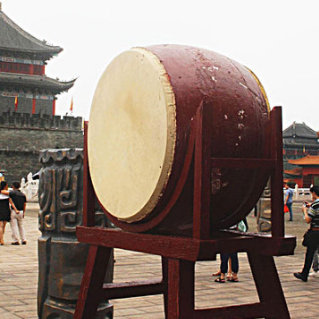zhangu overview
 War drums (pinyin: Zhàngǔ) are of different sizes, and are divided by the diameter of the drum surface. There are five sizes of 27, 33, 40, 46 and 54 cm, and their drum bodies are 17, 20, 24, 30 and 34 cm high respectively. The material used for making war drums is the same as that of Tanggu, but the drum body can also be made of basswood, with 2-4 drum rings in the middle. Play with a wooden hob. War drums were used on the battlefield in ancient times to send orders and boost morale. In modern times, they are mainly used in folk instrumental ensembles, dances, lantern festivals, acrobatics and gongs and drums.
War drums (pinyin: Zhàngǔ) are of different sizes, and are divided by the diameter of the drum surface. There are five sizes of 27, 33, 40, 46 and 54 cm, and their drum bodies are 17, 20, 24, 30 and 34 cm high respectively. The material used for making war drums is the same as that of Tanggu, but the drum body can also be made of basswood, with 2-4 drum rings in the middle. Play with a wooden hob. War drums were used on the battlefield in ancient times to send orders and boost morale. In modern times, they are mainly used in folk instrumental ensembles, dances, lantern festivals, acrobatics and gongs and drums.The pronunciation is lower than the drum, but very loud. During the march, it is usually carried by the person in front of the belt, and the person in the back is percussion, or the player's belt is slanted on the shoulders to percussion. It can also be played on a wooden drum stand.
Since the Ming Dynasty, the war drum has changed from the old system to an oblate shape. The drum frame is mostly made of wood, such as chun, se, birch, mulberry, and poplar. Both sides are covered with cowhide. The leather edge is fixed with a single row of drum nails. There are two drum rings on both sides of the drum frame. The war drums have different specifications and sizes. The diameter of the drum surface is 52 cm to 100 cm, and the height of the drum frame is 20 cm to 34 cm. The pronunciation is lower than that of the drum, but it is very loud. Mainly used in folk instrumental ensembles, dances, lantern festivals, acrobatics and gongs and drums. However, in the case of solemn and solemn scenes, the long drum is still used. The performers are highly skilled and can dance while striking.
- Pinyin:Zhàngǔ
- Features:Lower than drums, but very loud
- Drum diameter:46 and 54 cm etc.
- drum high:30 and 34 cm etc.
overview of other similar instruments
- sanyanxiao overview
- Daguangxian overview
- Leiqin overview
- hahao overview
- yandundagu overview
- Han Xiaozheng overview
- Fang Xiang overview
- guanzi overview
- zhuqin (Dao Qin) overview
- zhuiqin overview
- bangzi overview
- three-stringed piano overview
- Gehu overview
- xiao overview
- xiaokonghou overview
- Konghou overview
- Sheng overview
- suona overview
- hulusi overview
- gushao overview
 渝公网安备 50010702504639号
渝公网安备 50010702504639号